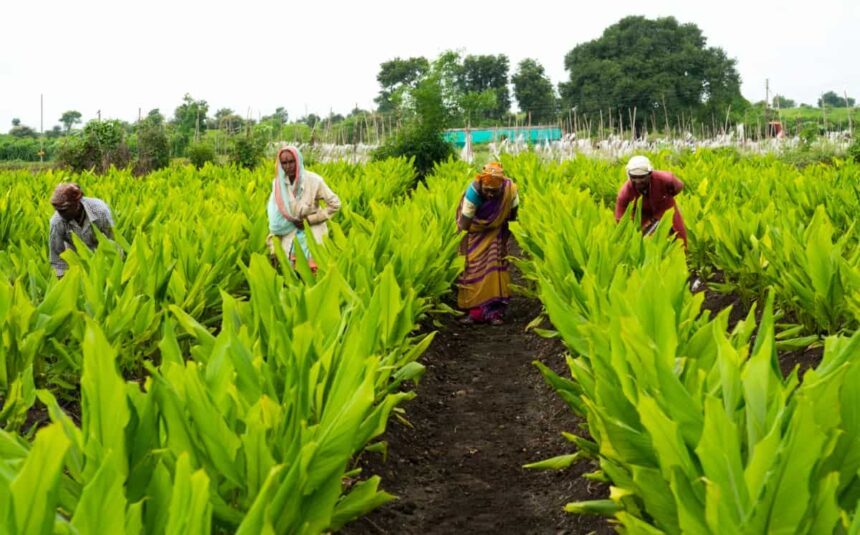Prime Minister Narendra Modi’s vision for Indian agriculture is a testament to his commitment to sustainability and farmer empowerment. The government’s focus on organic farming and traditional practices is not a step back, but a leap forward. It’s a strategic move to increase productivity, reduce costs, and improve market access, all while leveraging the power of technology.

Initiatives like the Paramparagat Krishi Vikas Yojana are not just about supporting farmers transitioning to organic methods, but also about fostering organic villages and sustainable practices through the use of technology. This vision is not just about aligning with global environmental goals, but also about promising a prosperous future for India’s agricultural community.
Key Agricultural Reforms Introduced by Modi’s Government
Under Prime Minister Modi’s administration, several key agricultural reforms were introduced to boost productivity, market access, and farmers’ incomes. The Farmers’ Produce Trade and Commerce Act allowed farmers to sell their produce outside the APMC (Agricultural Produce Market Committee) mandis without state restrictions.
The Farmers Agreement on Price Assurance and Farm Services Act provided a framework for farmers to enter into contract farming agreements, ensuring price assurance and better market linkages. The Essential Commodities (Amendment) Act aimed to deregulate the production, storage, movement, and distribution of essential commodities, reducing stock limits and promoting investment in cold storage and modernization.
Additionally, the Pradhan Mantri Kisan Samman Nidhi (PM-KISAN) scheme provided direct income support to farmers, and the PM-KUSUM scheme promoted solar energy usage in agriculture. These reforms collectively aimed to modernize Indian agriculture, enhance efficiency, and secure farmers’ livelihoods.
Impact of the Pradhan Mantri Fasal Bima Yojana
The Pradhan Mantri Fasal Bima Yojana, launched in 2016, is a comprehensive crop insurance scheme for financial support to farmers in case of crop loss or damage. The PMFBY scheme, which covers over 100 million hectares of farmland, has insured over 57 million farmers as of 2021. The scheme covers a significant portion of the agricultural community and is protected against natural calamities, pests, and diseases. Farmers pay a nominal premium rate, with the balance shared by the central and state governments.
Between 2016 and 2021, claims worth approximately ₹95,000 crores (around USD 12.8 billion) were disbursed to farmers, helping mitigate the financial burden on them due to crop loss. The government allocated ₹16,000 crores (around USD 2.15 billion) in the 2020-21 budget for PMFBY, underscoring its commitment to the scheme. The claim settlement ratio has improved over the years, with 85-90% of claims being settled promptly by 2021.
In case you missed it: Drone Farming, Drone Technology In Agriculture

States like Maharashtra, Madhya Pradesh, and Rajasthan have seen substantial benefits, with large numbers of enrolled farmers and significant claim settlements. PMFBY has provided risk mitigation and income to farmers, encouraging them to invest in better inputs and practices. Challenges and improvements include delayed payments, increased awareness and outreach, and technological integration using remote sensing and drones.
Doubling Farmers’ Income: Goals and Achievements
The Indian government, under Prime Minister Modi, set a goal to double farmers’ income by 2022 in an effort to increase agricultural productivity and profitability. Key initiatives included:
- Income Support Schemes: The PM-KISAN scheme provided ₹6,000 annually to over 110 million farmers, directly boosting their income.
- Market Reforms: The implementation of the Farmers’ Produce Trade and Commerce Act and contract farming laws improved market access and price realization.
- Technological Integration: The use of digital platforms like e-NAM (National Agriculture Market) facilitated better market linkages, benefiting over 1.7 million farmers.
- Investment in Infrastructure: The Agriculture Infrastructure Fund allocated ₹1 lakh crore for building farm-gate infrastructure and storage facilities.
- Diversification and Value Addition: Promoting horticulture, dairy, and fisheries alongside traditional crops increased farmers’ income streams.
Implementation of Soil Health Card Scheme
The Soil Health Card (SHC) Scheme, launched in 2015, aims to promote sustainable farming by providing farmers with detailed information on soil health. By 2021, over 220 million SHC cards had been distributed across India. Soil samples from 138 million farm holdings were collected and analyzed for 12 key soil parameters. The SHC scheme has improved fertilizer use efficiency, reduced costs by 8-10%, and improved crop yields by 10-12%.
It has also increased farmers’ awareness of soil health management practices, promoting balanced nutrient application. The government has set up and upgraded 1,215 soil testing labs, incorporating advanced technology for precise soil analysis. Digital platforms have streamlined the distribution and access to soil health data. The scheme has resulted in cost savings of 8-10% and increased crop productivity by 10-12%.
Role of e-NAM (National Agriculture Market)
The e-NAM (National Agriculture Market), launched in April 2016, aims to create a unified national market for agricultural commodities by integrating existing APMC mandis. As of 2021, over 1,000 mandis across 18 states and three union territories were integrated into e-NAM, facilitating transparent and efficient trade.
Key Impacts
- Farmers Benefited: Approximately 1.7 crore (17 million) farmers registered, enhancing their market access.
- Traders and Commission Agents: Over 1.3 lakh traders and 73,000 commission agents enrolled, broadening the network.
- Transactions and Value: By 2021, transactions worth ₹1.22 lakh crore (approximately USD 16.3 billion) were recorded, showcasing substantial trade volume.
Advantages
- Price Discovery: Improved price discovery for farmers due to increased competition.
- Reduced Market Fees: Uniform market fees across states reduce transaction costs.
- Quality Assurance: Grading and assaying facilities ensure quality, fetching better prices.
In case you missed it: Subsidy for Spirulina Cultivation: How Indian Government Schemes Encouraging Spirulina Farmers

Promoting Organic Farming: Paramparagat Krishi Vikas Yojana
The Paramparagat Krishi Vikas Yojana (PKVY) was launched in 2015 to promote organic farming and sustainable agricultural practices in India. The government allocated ₹1,600 crores (around USD 214 million) from 2015 to 2020, benefiting over 1.2 million farmers. Over 2.94 lakh hectares of farmland have been covered under organic cultivation, and around 10,000 clusters, each comprising 50 acres, have been formed to facilitate organic farming practices.
Farmers receive ₹50,000 per hectare for three years, covering organic inputs, certification, and training. The scheme has improved soil fertility and biodiversity, enhanced market access for organic produce, reduced environmental pollution, and better health outcomes due to lower chemical usage.
Irrigation Initiatives: Pradhan Mantri Krishi Sinchai Yojana
The Pradhan Mantri Krishi Sinchai Yojana (PMKSY), launched in 2015, aims to enhance irrigation coverage and improve water use efficiency in agriculture through its slogan “Har Khet Ko Pani” (Water for Every Field).
Key Components and Achievements
- Budget Allocation: The scheme received ₹50,000 crores (around USD 6.7 billion) for implementation over five years.
- Micro-Irrigation: Over 1.42 million hectares have been brought under micro-irrigation, promoting efficient water usage.
- Watershed Development: 2.9 million hectares were treated for watershed management, enhancing soil moisture and reducing erosion.
- Per Drop More Crop: This component, emphasizing water-saving technologies, facilitated the installation of drip and sprinkler systems on over 870,000 hectares.
Impact and Benefits
- Irrigation Coverage: Increased irrigation coverage has reached an additional 4.3 million hectares.
- Farmer Benefits: Improved crop yields and productivity, leading to higher incomes for farmers.
- Water Efficiency: Enhanced water use efficiency by 20-30%, contributing to sustainable agricultural practices.
PM-KISAN Scheme: Financial Support to Farmers
The Pradhan Mantri Kisan Samman Nidhi scheme, launched in February 2019, provides direct financial support to farmers to ensure a steady income and mitigate agricultural distress.
Key Components and Achievements
- Annual Payment: Under PM-KISAN, each eligible farmer receives ₹6,000 annually, disbursed in three equal installments of ₹2,000 each.
- Budget Allocation: The scheme’s allocation for the fiscal year 2021-22 was ₹65,000 crores (around USD 8.7 billion).
- Beneficiaries: As of 2023, over 115 million farmers, including small and marginal farmers with landholdings up to 2 hectares, have benefited from the scheme.
Impact and Benefits
- Financial Aid: Direct financial support has improved farmers’ liquidity, enabling them to purchase essential inputs like seeds and fertilizers.
- Economic Stability: The scheme has contributed to economic stability in rural areas, reducing farmers’ dependency on loans and informal credit sources.
- Prompt Disbursement: Timely payments have ensured that farmers receive financial assistance when most needed, particularly during sowing and harvesting seasons.
In case you missed it: Agriculture Drone Subsidy Scheme: Government Kisan Subsidy, License, and How to Apply Online

Agricultural Infrastructure Development under Modi’s Tenure
During Prime Minister Modi’s tenure, significant strides were made in developing agricultural infrastructure to support farmers and boost the sector’s efficiency and productivity.
Key Initiatives and Achievements
- Agriculture Infrastructure Fund (AIF): Launched in 2020, this scheme allocated ₹1 lakh crore (around USD 13.4 billion) to develop infrastructure such as cold storage, processing units, and markets.
- Cold Storage Capacity: Cold storage capacity increased by 15%, reducing post-harvest losses and improving the shelf life of perishable produce.
- E-NAM (National Agriculture Market): Over 1,000 mandis were integrated into the electronic National Agriculture Market, facilitating better price discovery and market access for farmers.
- Warehousing: Warehouse capacity expanded by 20 million metric tons, ensuring better storage facilities for grains and other produce.
- Rural Roads: The Pradhan Mantri Gram Sadak Yojana improved rural connectivity, with over 190,000 km.
The Controversial Farm Laws: Overview and Impact
The three controversial farm laws introduced by the Modi government in 2020 aimed to liberalize agricultural markets but faced significant opposition from farmers. Here’s an overview and their impact:
- Farmers’ Produce Trade and Commerce Act: Allowed farmers to sell produce outside APMC mandis without state taxes, aiming to create more competitive markets.
- Farmers Agreement on Price Assurance and Farm Services Act: Enabled contract farming, providing a framework for agreements between farmers and buyers.
- Essential Commodities (Amendment) Act: Removed stock limits on essential commodities, aiming to attract private investment.
Impact and Controversy
- Protests: Farmers, particularly from Punjab and Haryana, protested, fearing the laws would dismantle the APMC system and lead to corporate exploitation.
- Market Dynamics: While the goal is to provide better market access, farmers want to maintain a guaranteed MSP (Minimum Support Price).
- Economic Impact: Potentially increased market opportunities but risked creating market imbalances and price volatility.
- Political Backlash: The laws were repealed in November 2021 following prolonged protests and significant political pressure.
Encouraging Agri-Tech and Innovation
Under Prime Minister Modi’s vision for Indian agriculture, encouraging agri-tech and innovation has been a cornerstone to modernize the sector, improve productivity, and ensure food security.
The National Agricultural Market (e-NAM) and AgriTech Startup Challenge are digital platforms promoting market access, price discovery, and information dissemination. Increased funding for agricultural research institutions is being used to develop technologies like precision farming, drones, and IoT devices. Agri-tech startups are supported through schemes like AGRI-UDAAN and ATAL Innovation Mission.
In case you missed it: Government Subsidy for Oil Palm Crops in India: State-wise Oil Palm Cultivation Subsidies

Extension services leverage technology to provide farmers with timely advice on crop management and market trends. Investment in rural infrastructure facilitates the adoption of agri-tech solutions. The vision is to promote sustainable agriculture, empower farmers, ensure food security, and position Indian agriculture as globally competitive by embracing innovation and cutting-edge technologies.
Support for Allied Activities: Dairy, Poultry, and Fisheries
Dairy Sector: Schemes like the Dairy Processing and Infrastructure Development Fund (DIDF) provide financial assistance for modernizing dairy infrastructure, boosting milk processing capacities, and increasing value addition.
Poultry Industry: Initiatives like the National Livestock Mission support poultry farming through breed improvement, disease control, and infrastructure development, ensuring sustainable growth and better livelihoods for farmers.
Fisheries: Schemes such as the Blue Revolution aim to enhance fish production and promote aquaculture by providing financial assistance for fisheries infrastructure, technology adoption, and training, thus contributing to nutritional security and rural livelihoods.
Sustainable Agriculture Practices and Environmental Concerns
Under Modi’s vision for Indian agriculture, sustainable practices, and environmental concerns are paramount. Initiatives like the Soil Health Card scheme promote soil conservation and efficient fertilizer use. The Pradhan Mantri Krishi Sinchai Yojana focuses on water management, reducing water wastage, and enhancing irrigation efficiency.
Additionally, the Paramparagat Krishi Vikas Yojana encourages organic farming, reducing chemical inputs and promoting biodiversity. These efforts align with India’s commitments to climate action and sustainable development, aiming to ensure long-term agricultural productivity while mitigating environmental degradation and addressing the challenges of climate change.
Empowering Women in Agriculture
Under Modi’s agricultural vision, empowering women in agriculture is prioritized for inclusive growth. Initiatives like the Mahila Kisan Sashaktikaran Pariyojana provide training, resources, and financial assistance to women farmers. Schemes like PM-Kisan also ensure direct income support to women farmers.
In case you missed it: Government Subsidy for Vegetable Crops in India: How to Avail up to 40–60% under MIDH Scheme

Furthermore, efforts to improve access to credit, land rights, and technology for women in rural areas are underway. By recognizing the vital role women play in agriculture and providing them with support and opportunities, the government aims to enhance their participation, improve their livelihoods, contribute to agricultural development.
Under Modi’s leadership, Indian agriculture is poised for transformation. Through technological innovation, sustainable practices, and inclusive policies, the sector aims to enhance productivity, empower farmers, and ensure food security. With a focus on modernization and resilience, Indian agriculture is set to thrive in the coming years.







